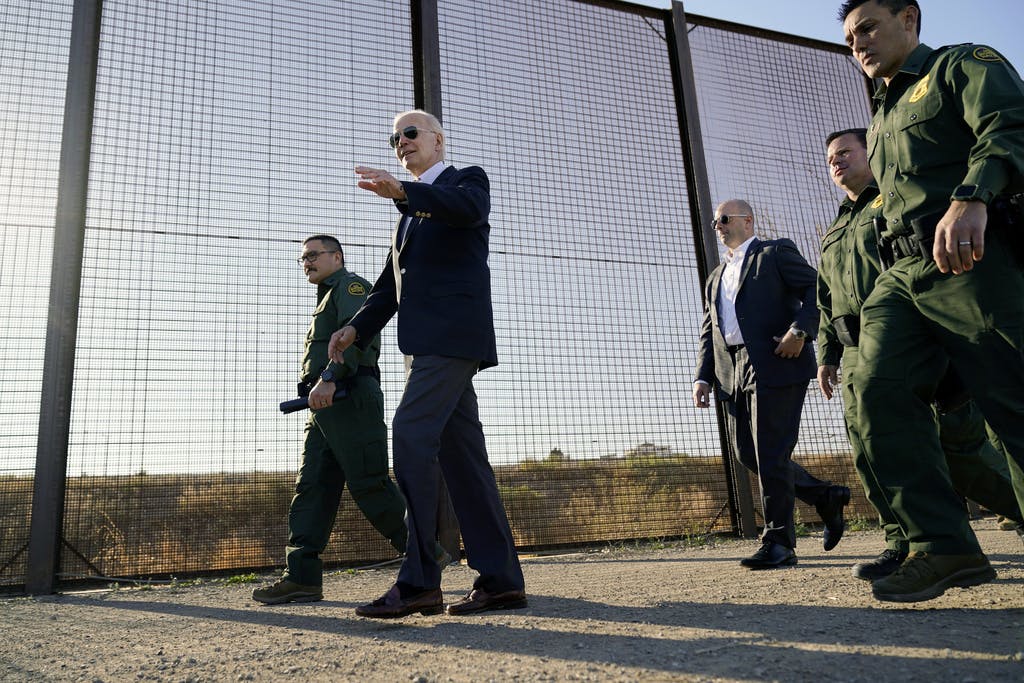To Ease Crisis at the Border, Biden Opens Door to 100,000 More Migrants From Central America
Absent from the new negotiations over migration is Vice President Harris, who was designated by Biden early on to handle the crisis at the border.

Mexico’s president will cooperate with President Biden on a key migration policy after the Trump-era border policy known as Title 42 expires next week, officials in Mexico City have announced.
According to an agreement between the two countries signed Tuesday, Mexico will maintain its policy of taking in deported nationals from Venezuela, Haiti, Cuba, and Nicaragua — with a new wrinkle: Mr. Biden will now allow up to 100,000 additional migrants from three more countries into America.
Under a family reunification parole program, nationals of El Salvador, Guatemala, and Honduras who have relatives in America will be admitted into the country legally while they await their visas.
Absent from the new negotiations over migration is Vice President Harris, who was designated by Mr. Biden early on to handle the crisis at the border. Instead, Mexico’s president, Andrés Manuel López Obrador, met Tuesday with an American homeland security advisor, Elizabeth Sherwood-Randall, an Obama administration alumnus who specializes in European security affairs.
Their discussions Tuesday at Mexico City were about joint efforts to address the burgeoning number of migrants waiting to cross the border. The new policies will come into effect on May 11, when the national Covid-era health emergency is lifted and the protocol known as Title 42, which allows for the expulsion of asylum seekers on health-related grounds, also ends.
According to a joint statement, officials from Mexico and America have added policies to address the unprecedented flow at the border and to build on the initiatives that the governments already have in place.
“Today, the United States committed to continue to welcome individuals from Cuba, Haiti, Nicaragua, and Venezuela under our parole process. For its part, Mexico will continue to accept back migrants on humanitarian grounds,” the statement said.
Mr. Biden announced in January that Mexico agreed to accept migrants from Cuba, Nicaragua, and Haiti who were deported for attempting to cross the border illegally. In exchange, America agreed to take in up to 30,000 pre-approved migrants from those countries every month. A separate program established last October is already taking in 24,000 Venezuelan migrants a month.
For now, there is no discernible benefit for the Mexican government, a former diplomat who is president of a consulting firm, Rozental & Asociados, Andres Rozental, tells the Sun. One possible concession to the Mexican president, he said, is that Washington would perhaps overlook Mr. López Obrador’s record on human rights, energy, and other policies on which the two countries disagree.
The situation on the ground will not change much, according to a policy director at the American Immigration Council, Aaron Reichlin-Melnick. From a legal perspective, though, it’s a big shift. “At no point in U.S. history has there ever been another country which would take large numbers of deportations from the U.S. of people who aren’t nationals of that country,” Mr. Reichlin-Melnick said.
The American secretary of state, Antony Blinken, and homeland security secretary, Alejandro Mayorkas, announced last week the establishment of two new processing centers in Guatemala and Colombia where migrants can apply for refugee status without having to travel to the American border. The centers aim to screen up to 6,000 would-be migrants a month.
During the meeting Tuesday, Mexican officials recognized the “great potential value” of the processing centers, the statement said. As many as 100,000 individuals from Honduras, Guatemala, and El Salvador will be able to enter America under the family reunification program that already allows Cuban and Haitians to enter America legally.
Migrant encounters at the southern border have climbed significantly in April and May in anticipation of the end of Title 42, an official with the Department of Homeland Security tells the Sun. The official, who is not unauthorized to speak to the press, spoke on the condition of anonymity.
Migrant shelters in Ciudad Juarez, across the border from El Paso, are also up to full capacity. The director of the shelter Casa del Migrante, Francisco Bueno, tells the Sun that in Ciudad Juarez, there are at least 15,000 migrants looking for shelter. In general, the average number of people in the city has been 3,000.
During their Tuesday meeting, the Mexican and American officials also announced intentions to increase action against human smugglers and traffickers at the border and to enhance efforts in Central America to address the root causes of migration. In addition, they said they plan to modernize the shared border.

